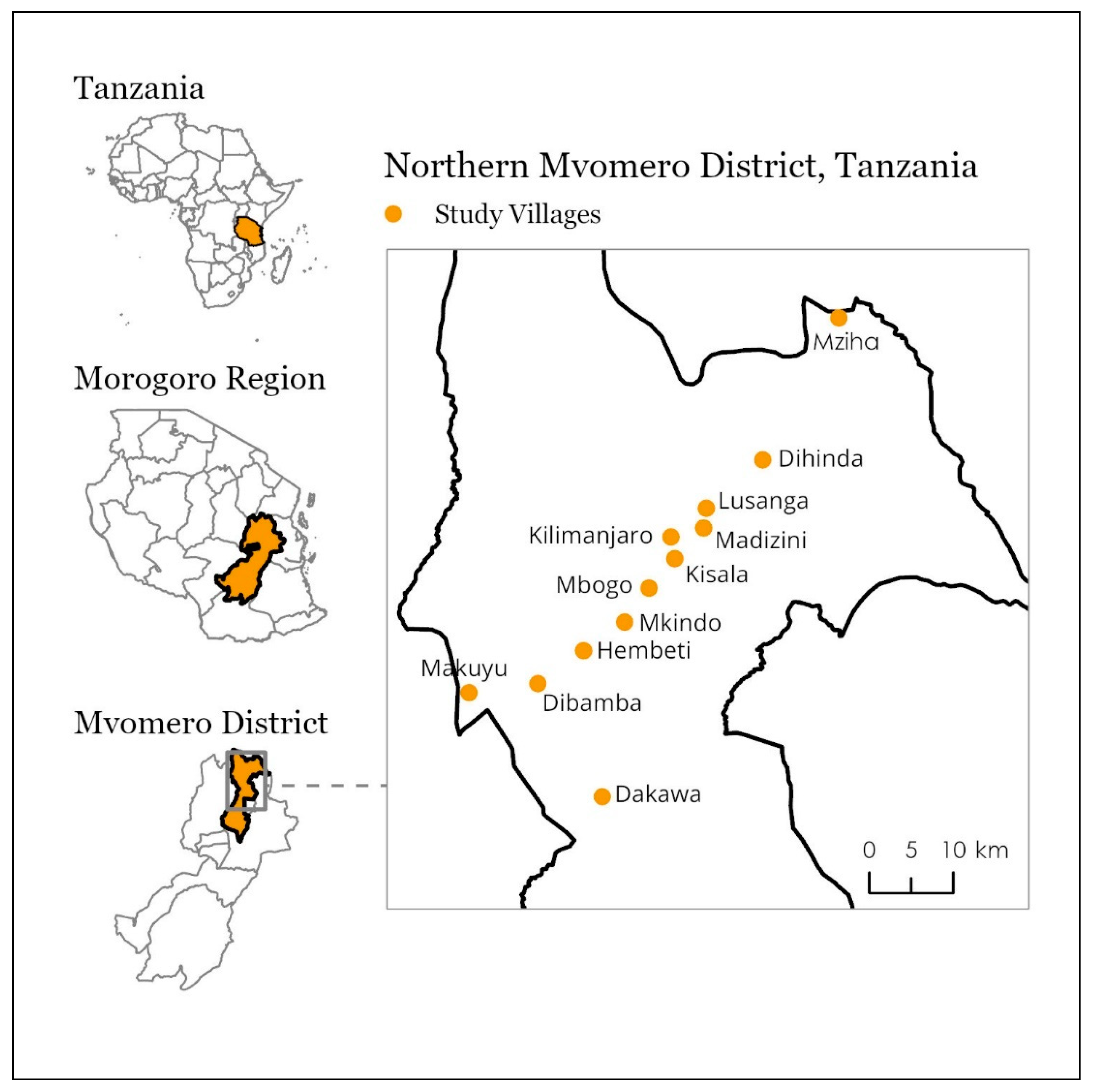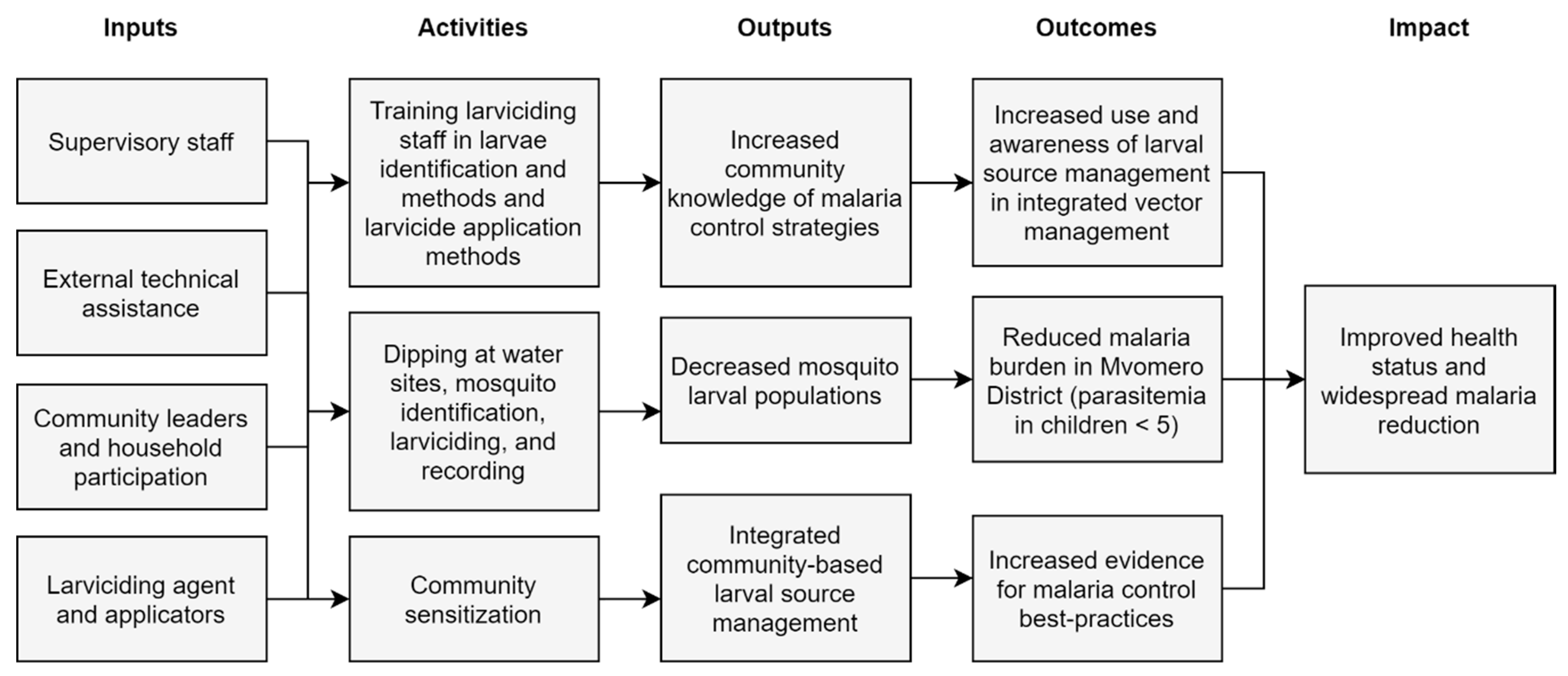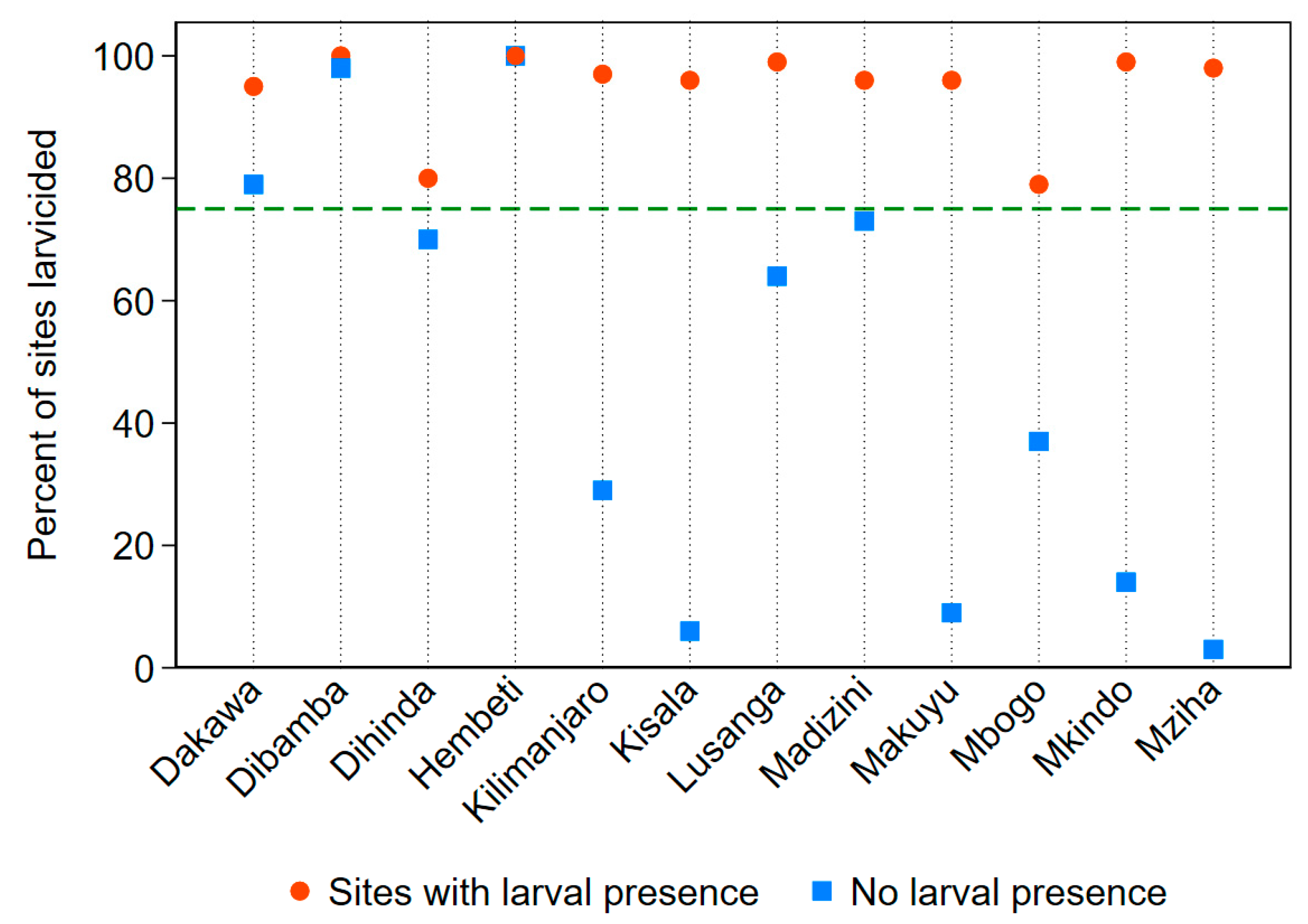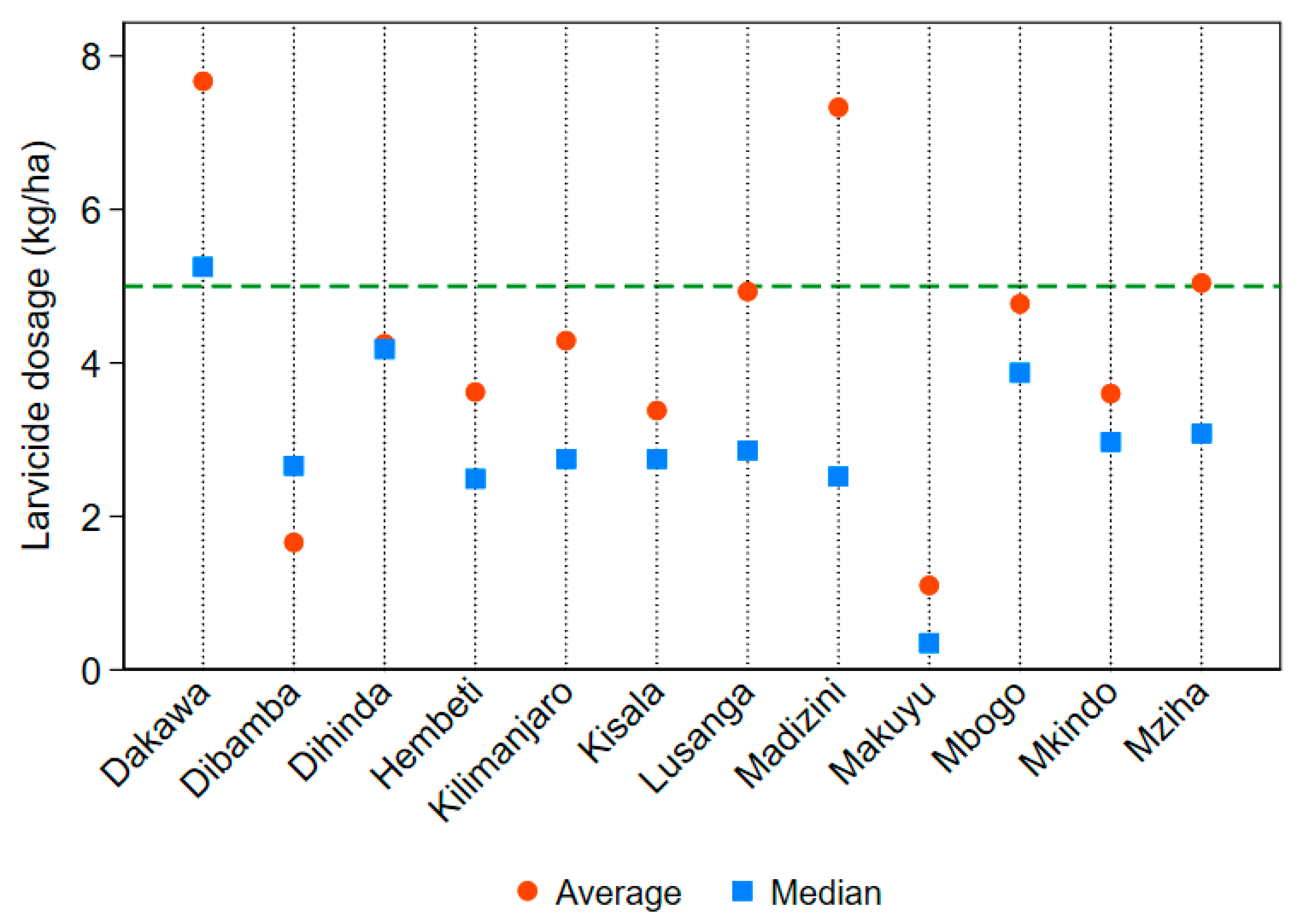Process Evaluation of a Community-Based Microbial Larviciding Intervention for Malaria Control in Rural Tanzania
Abstract
1. Introduction
2. Materials and Methods
2.1. Study Setting
2.2. Logic Model
2.3. Data Analysis
2.3.1. Quantitative Indicators
- Greater than 75% of breeding habitats receiving larvicide application (reach);
- At least 5 kg per hectare of larvicide being applied at each site (exposure);
- At least 50% of sites receiving an adequate dosage according to manufacturer instructions (fidelity).
2.3.2. Qualitative Indicators
3. Results
3.1. Quantitative Analysis
3.1.1. Overall Larviciding Activity
3.1.2. Reach: Percentage of Visits with Larvicide Application
3.1.3. Exposure: Mean and Median Larvicide Dosage Applied
3.1.4. Fidelity: Percentage of Sites Receiving an Adequate Application Dosage
3.1.5. Additional Analysis of Application Adequacy
3.2. Qualitative Analysis
4. Discussion
Recommendations to Improve Future Interventions
5. Conclusions
Author Contributions
Funding
Acknowledgments
Conflicts of Interest
References
- World Malaria Report 2019; World Health Organization: Geneva, Switzerland, 2019.
- Kramer, R.A.; Mboera, L.E.G.; Senkoro, K.; Lesser, A.; Shayo, E.H.; Paul, C.J.; Miranda, M.L. A randomized longitudinal factorial design to assess malaria vector control and disease management interventions in rural Tanzania. Int. J. Environ. Res. Public Health 2014, 11, 5317–5332. [Google Scholar] [CrossRef] [PubMed]
- Fillinger, U.; Kannady, K.; William, G.; Vanek, M.J.; Dongus, S.; Nyika, D.; Geissbühler, Y.; Chaki, P.P.; Govella, N.J.; Mathenge, E.M.; et al. A tool box for operational mosquito larval control: Preliminary results and early lessons from the Urban Malaria Control Programme in Dar es Salaam, Tanzania. Malar. J. 2008, 7, 20. [Google Scholar] [CrossRef] [PubMed]
- Mboera, L.; Mazigo, H.; Rumisha, S.; Kramer, R. Towards Malaria Elimination and its Implication for Vector Control, Disease Management and Livelihoods in Tanzania. Malar. World J. 2013, 4, 1–14. [Google Scholar]
- Rahman, R.; Lesser, A.; Mboera, L.; Kramer, R. Cost of microbial larviciding for malaria control in rural Tanzania. Trop. Med. Int. Health 2016, 21, 1468–1475. [Google Scholar] [CrossRef] [PubMed]
- Fillinger, U.; Lindsay, S.W. Suppression of exposure to malaria vectors by an order of magnitude using microbial larvicides in rural Kenya. Trop. Med. Int. Health 2006, 11, 1629–1642. [Google Scholar] [CrossRef] [PubMed]
- Larval Source Management: A Supplementary Measure for Malaria Vector Control; World Health Organization: Geneva, Switzerland, 2013.
- Majambere, S.; Lindsay, S.W.; Green, C.; Kandeh, B.; Fillinger, U. Microbial larvicides for malaria control in The Gambia. Malar. J. 2007, 6, 76. [Google Scholar] [CrossRef] [PubMed]
- Geissbühler, Y.; Kannady, K.; Chaki, P.P.; Emidi, B.; Govella, N.J.; Mayagaya, V.; Kiama, M.; Mtasiwa, D.; Mshinda, H.; Lindsay, S.W.; et al. Microbial larvicide application by a large-scale, community-based program reduces malaria infection prevalence in urban Dar es Salaam, Tanzania. PLoS ONE 2009, 4, e5107. [Google Scholar] [CrossRef]
- Mboera, L.E.G.; Kramer, R.A.; Miranda, M.L.; Kilima, S.P.; Shayo, E.H.; Lesser, A. Community knowledge and acceptance of larviciding for malaria control in a rural district of east-central Tanzania. Int. J. Environ. Res. Public Health 2014, 11, 5137–5154. [Google Scholar] [CrossRef] [PubMed]
- Mittal, P.K. Biolarvicides in vector control: Challenges and prospects. J. Vector Borne Dis. 2003, 40, 20–32. [Google Scholar] [PubMed]
- Fillinger, U.; Ndenga, B.; Githeko, A.; Lindsay, S.W. Integrated malaria vector control with microbial larvicides and insecticide-treated nets in western Kenya: A controlled trial. Bull. World Health Organ. 2009, 87, 655–665. [Google Scholar] [CrossRef] [PubMed]
- Charles, J.-F.; Nielsen-LeRoux, C. Mosquitocidal bacterial toxins: Diversity, mode of action and resistance phenomena. Mem. Inst. Oswaldo Cruz 2000, 95, 201–206. [Google Scholar] [CrossRef] [PubMed]
- Steckler, A.; Linnan, L. Process. Evaluation for Public Health Interventions and Research; Jossey-Bass: San Francisco, CA, USA, 2002; ISBN 978-1-119-02248-0. [Google Scholar]
- Module 5: Process Evaluation. Available online: http://www.uniteforsight.org/evaluation-course/module5 (accessed on 2 July 2020).
- Hulscher, M.; Laurant, M.; Grol, R. Process evaluation on quality improvement interventions. Qual. Saf. Health Care 2003, 12, 40–46. [Google Scholar] [CrossRef] [PubMed]
- Logic Model Development Guide 2004. Available online: https://www.wkkf.org/resource-directory/resources/2004/01/logic-model-development-guide (accessed on 2 July 2020).
- Ladd, S.; Jernigan, J.; Watkins, N.; Minta, B.; Brown, S. Evaluation Guide: Developing and Using a Logic Model. Available online: https://www.cdc.gov/dhdsp/docs/logic_model.pdf (accessed on 2 July 2020).
- Chandler, C.I.; DiLiberto, D.; Nayiga, S.; Taaka, L.; Nabirye, C.; Kayendeke, M.; Hutchinson, E.; Kizito, J.; Maiteki-Sebuguzi, C.; Kamya, M.R.; et al. The PROCESS study: A protocol to evaluate the implementation, mechanisms of effect and context of an intervention to enhance public health centres in Tororo, Uganda. Implement. Sci. 2013, 8, 113. [Google Scholar] [CrossRef] [PubMed][Green Version]
- VectoBac Granule: Biological Larvicide. Valent BioSciences. 2014. Available online: https://www.valentbiosciences.com/publichealth/wp-content/uploads/sites/4/2019/04/VectoBac-Granule-Technical-Use-Sheet-sp.pdf (accessed on 2 July 2020).
- Dambach, P.; Traoré, I.; Kaiser, A.; Sié, A.; Sauerborn, R.; Becker, N. Challenges of implementing a large scale larviciding campaign against malaria in rural Burkina Faso - lessons learned and recommendations derived from the EMIRA project. BMC Public Health 2016, 16, 1023. [Google Scholar] [CrossRef] [PubMed]
- Reynolds, J.; DiLiberto, D.; Mangham-Jefferies, L.; Ansah, E.K.; Lal, S.; Mbakilwa, H.; Bruxvoort, K.; Webster, J.; Vestergaard, L.S.; Yeung, S.; et al. The practice of “doing” evaluation: Lessons learned from nine complex intervention trials in action. Implement. Sci 2014, 9, 75. [Google Scholar] [CrossRef] [PubMed]
- Fillinger, U.; Sonye, G.; Killeen, G.F.; Knols, B.G.J.; Becker, N. The practical importance of permanent and semipermanent habitats for controlling aquatic stages of Anopheles gambiae sensu lato mosquitoes: Operational observations from a rural town in western Kenya. Trop. Med. Int. Health 2004, 9, 1274–1289. [Google Scholar] [CrossRef] [PubMed]






| Indicator | Analysis | Metrics | Standard |
|---|---|---|---|
| Reach | Quantitative | Percentage of breeding habitats identified with subsequent larvicide application | >75% |
| Exposure | Quantitative | Mean and median larvicide application dosage | ≥5 kg per hectare |
| Fidelity | Quantitative | Percentage of breeding habitats identified receiving an adequate dosage of larvicide (≥5 kg/ha) | ≥50% |
| Resources | Qualitative | Review of supervisor reports and in-depth interviews with larviciding staff | Not applicable |
© 2020 by the authors. Licensee MDPI, Basel, Switzerland. This article is an open access article distributed under the terms and conditions of the Creative Commons Attribution (CC BY) license (http://creativecommons.org/licenses/by/4.0/).
Share and Cite
Berlin Rubin, N.; Mboera, L.E.G.; Lesser, A.; Miranda, M.L.; Kramer, R. Process Evaluation of a Community-Based Microbial Larviciding Intervention for Malaria Control in Rural Tanzania. Int. J. Environ. Res. Public Health 2020, 17, 7309. https://doi.org/10.3390/ijerph17197309
Berlin Rubin N, Mboera LEG, Lesser A, Miranda ML, Kramer R. Process Evaluation of a Community-Based Microbial Larviciding Intervention for Malaria Control in Rural Tanzania. International Journal of Environmental Research and Public Health. 2020; 17(19):7309. https://doi.org/10.3390/ijerph17197309
Chicago/Turabian StyleBerlin Rubin, Nina, Leonard E.G. Mboera, Adriane Lesser, Marie Lynn Miranda, and Randall Kramer. 2020. "Process Evaluation of a Community-Based Microbial Larviciding Intervention for Malaria Control in Rural Tanzania" International Journal of Environmental Research and Public Health 17, no. 19: 7309. https://doi.org/10.3390/ijerph17197309
APA StyleBerlin Rubin, N., Mboera, L. E. G., Lesser, A., Miranda, M. L., & Kramer, R. (2020). Process Evaluation of a Community-Based Microbial Larviciding Intervention for Malaria Control in Rural Tanzania. International Journal of Environmental Research and Public Health, 17(19), 7309. https://doi.org/10.3390/ijerph17197309





